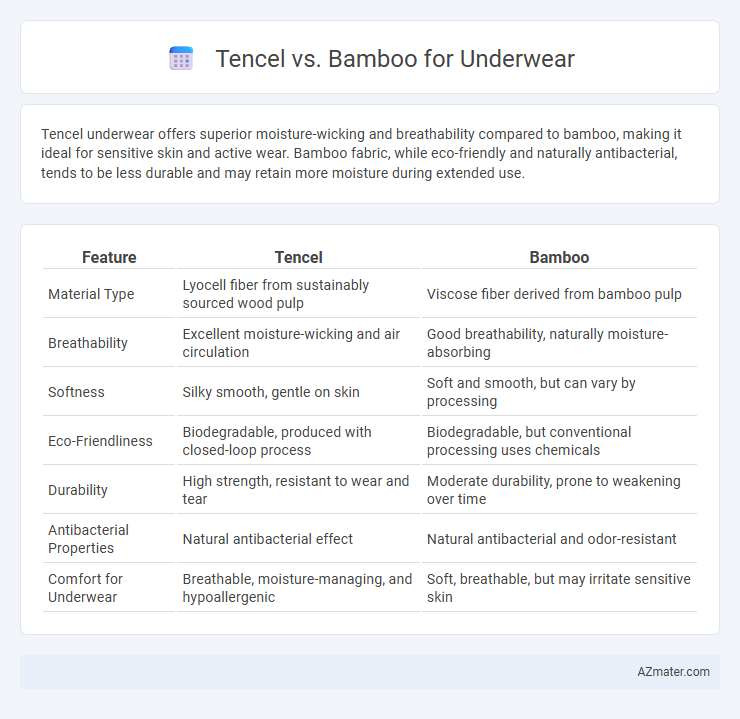Tencel underwear offers superior moisture-wicking and breathability compared to bamboo, making it ideal for sensitive skin and active wear. Bamboo fabric, while eco-friendly and naturally antibacterial, tends to be less durable and may retain more moisture during extended use.
Table of Comparison
| Feature | Tencel | Bamboo |
|---|---|---|
| Material Type | Lyocell fiber from sustainably sourced wood pulp | Viscose fiber derived from bamboo pulp |
| Breathability | Excellent moisture-wicking and air circulation | Good breathability, naturally moisture-absorbing |
| Softness | Silky smooth, gentle on skin | Soft and smooth, but can vary by processing |
| Eco-Friendliness | Biodegradable, produced with closed-loop process | Biodegradable, but conventional processing uses chemicals |
| Durability | High strength, resistant to wear and tear | Moderate durability, prone to weakening over time |
| Antibacterial Properties | Natural antibacterial effect | Natural antibacterial and odor-resistant |
| Comfort for Underwear | Breathable, moisture-managing, and hypoallergenic | Soft, breathable, but may irritate sensitive skin |
Introduction to Tencel and Bamboo Fabrics
Tencel fabric, derived from sustainably sourced eucalyptus wood pulp, is known for its exceptional softness, breathability, and moisture-wicking properties, making it ideal for comfortable underwear. Bamboo fabric, made from bamboo cellulose, offers natural antibacterial qualities, high absorbency, and a silky texture that enhances comfort and freshness throughout the day. Both materials are eco-friendly alternatives to traditional cotton, with Tencel emphasizing sustainable forestry and bamboo highlighting rapid renewable growth.
How Tencel and Bamboo Underwear Are Made
Tencel underwear is made from sustainably sourced wood pulp, primarily eucalyptus trees, through a closed-loop process that recycles water and solvents, resulting in a soft, breathable fabric with excellent moisture-wicking properties. Bamboo underwear is produced by mechanically crushing bamboo culms into a fibrous pulp, which is then chemically processed to create viscose or rayon fibers known for their softness and antibacterial qualities. Both methods emphasize eco-friendly production, but Tencel's closed-loop system offers a more environmentally responsible and efficient manufacturing approach compared to traditional bamboo viscose processes.
Comfort and Softness: Tencel vs Bamboo
Tencel underwear offers exceptional moisture-wicking properties and a smooth, silky texture that enhances comfort during prolonged wear. Bamboo fabric is naturally breathable and antibacterial, providing softness comparable to cotton with added durability. Both materials excel in softness, but Tencel's temperature-regulating capabilities often result in superior comfort in various climates.
Moisture-Wicking and Breathability
Tencel underwear offers superior moisture-wicking capabilities due to its lyocell fibers, which efficiently draw sweat away from the skin, keeping you dry and comfortable. Bamboo fabric is highly breathable, allowing excellent air circulation, but its moisture-wicking properties, though good, generally fall short compared to Tencel. Both materials are eco-friendly options, but for optimal moisture management and breathability in underwear, Tencel is often considered the better choice.
Hypoallergenic Properties and Skin Sensitivity
Tencel and bamboo fabrics both offer excellent hypoallergenic properties ideal for sensitive skin, but Tencel is often preferred due to its smoother fiber structure that minimizes irritation and reduces allergen retention. Bamboo underwear is naturally antimicrobial and moisture-wicking, making it suitable for sensitive skin, yet some manufacturing processes may involve chemicals that could affect allergy-prone individuals. Choosing Tencel underwear ensures enhanced breathability and softness, which effectively supports skin health in hypoallergenic clothing options.
Environmental Impact: Sustainability Comparison
Tencel, derived from sustainably managed eucalyptus forests, utilizes a closed-loop process that recycles water and solvents, minimizing environmental impact. Bamboo underwear production often involves chemical-intensive processes like viscose production, which can contribute to pollution unless sourced from certified organic and mechanically processed fibers. Overall, Tencel offers a more eco-friendly alternative due to its reduced water usage, biodegradability, and sustainable forestry practices compared to conventional bamboo fabric manufacturing.
Durability and Longevity of Each Fabric
Tencel, made from sustainably sourced eucalyptus wood pulp, offers superior durability due to its strong fiber structure and resistance to pilling, ensuring long-lasting underwear performance. Bamboo fabric, though soft and moisture-wicking, tends to weaken faster with repeated washing and wear, leading to reduced longevity compared to Tencel. Choosing Tencel underwear maximizes durability and maintains fabric integrity over time, making it a more sustainable option for everyday use.
Care and Maintenance of Tencel vs Bamboo Underwear
Tencel underwear offers superior moisture-wicking properties, making it less prone to odors and requiring less frequent washing than bamboo fabric. Bamboo underwear, while naturally antibacterial, demands gentle washing in cold water to preserve its softness and prevent fiber degradation. Both fabrics benefit from air drying to maintain shape and durability, but Tencel withstands higher wash temperatures better than bamboo, enhancing longevity.
Price and Availability in the Market
Tencel underwear generally carries a higher price point due to its sustainable production process and moisture-wicking properties, while bamboo underwear tends to be more affordable and widely available in various retail outlets. The availability of bamboo fabric is more widespread because of its faster cultivation and processing, making bamboo underwear a common choice for budget-conscious consumers. Market demand and brand positioning also influence pricing, with Tencel being favored in premium, eco-friendly lingerie collections.
Which is Better for Underwear: Tencel or Bamboo?
Tencel and bamboo fibers both offer excellent softness and breathability, but Tencel outperforms bamboo in moisture-wicking and durability, making it better suited for underwear. Tencel's eco-friendly closed-loop production process also reduces environmental impact compared to traditional bamboo processing methods. For underwear that balances comfort, performance, and sustainability, Tencel is often the preferred choice.

Infographic: Tencel vs Bamboo for Underwear
 azmater.com
azmater.com